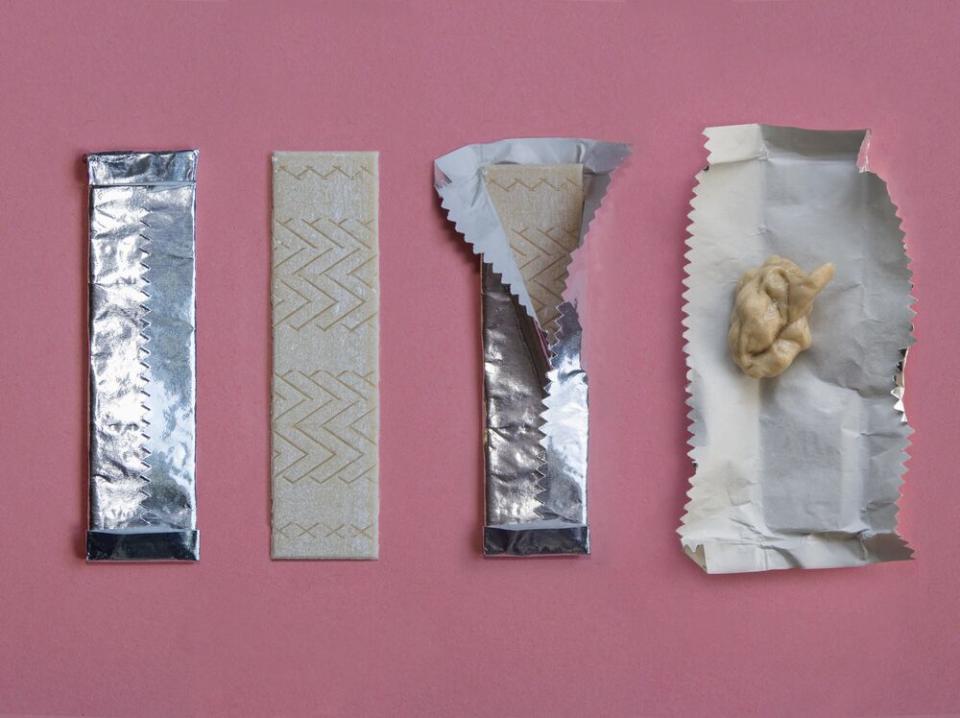What Happens When You Swallow Gum?
Does it really take your body seven years to digest chewing gum—or is that just a (very effective) myth designed to keep children from swallowing their Dubble Bubble? Here’s what you need to know:
Does Swallowed Gum Really Stay In Your System For Seven Years?

Nope. Consider that myth officially busted.
Your body will usually take care of gum in just a few days.
So How Does Your Body Digest Gum?
It’s true that your body isn’t really made to digest gum. However, that doesn’t mean it just hangs out in your stomach for years like an unwelcome houseguest—it makes its way through your system just like any other indigestible food. Consider corn, for example.
Chewing gum’s journey through your body goes like this: After you swallow it, the gum goes through your esophagus and into your small intestine. The small intestine absorbs what it can—in this case, it’s mostly sugar. Then it sends what’s leftover on its merry way to the colon and, subsequently, the rectum.
This great adventure ends, hopefully unceremoniously, in a trip to the bathroom.
“Gum is pretty immune to the digestive process. It probably passes through slower than most foodstuffs, but eventually the normal housekeeping waves in the digestive tract will sort of push it through, and it will come out pretty unmolested,” pediatric gastroenterologist David Milov said to Yale Scientific.
Is It Dangerous to Swallow Gum?

Usually, no. The occasional swallow should leave you with no ill effects.
However, you shouldn’t make gum swallowing a habit.
Large amounts, swallowed all at once or over a few days, can cause dangerous intestinal blockages.
While nobody should swallow gum regularly, this practice is especially dangerous for children.
A 1998 report presented three case studies of children who developed bezoars (solid masses of indigestible material) after swallowing chewing gum.
In one case, an exam of a 4-year-old girl suffering from constipation revealed a palpable firm mass in the rectum.
“The fecal mass was unmistakably chewing gum, because it contained multiple spheres of chewed gum congealed into a multicolored rectal mass,” according to the report. “Dislodging the mass revealed the taffy-pull sign. Ganglion cells were evident on rectal suction biopsy. After the disimpaction, the family reported that chewing gum was part of a positive reinforcement system used on many occasions each day. The child had the habit of swallowing gum, often just to get another piece.”
An even more frightening case involved a 1-year-old who was brought to the emergency room because of drooling, cough, and difficulty swallowing. It turned out that the child had swallowed large amounts of gum and coins—this could-be deadly combination formed a bezoar in her esophagus.
The bottom line? Children probably shouldn’t be allowed to have gum until they’re able to understand that it’s for chewing and not swallowing.
Related: 20 Foods That Make You Poop
When Should You Worry?

Bezoars typically form in the stomach, though they can form in the esophagus or in the intestines.
Bezoar symptoms include:
Loss of appetite
A feeling of fullness
Vomiting
Gastric ulcers
In severe cases, bezoars can lead to an intestinal blockage.
Symptoms of an intestinal blockage include:
Abdominal cramps
Constipation
Inability to pass gas
Loss of appetite
Vomiting
If you are worried about a bezoar or blockage, seek medical help ASAP.

